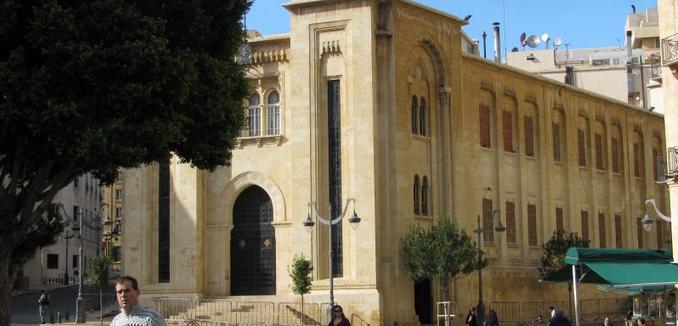Having effectively taken over the Lebanese cabinet in late December, the terrorist group Hezbollah appears to be on its way to completely controlling the country’s political arena, David Daoud, a research analyst at the Foundation for Defense of Democracies, wrote in Newsweek on Thursday
“Hezbollah is seizing the state’s institutions one by one,” Daoud wrote, noting the recent election of Hezbollah ally and former general Michael Aoun to the presidency, as well as the installation of key Hezbollah allies to the posts of justice minister and defense minister.
Following the resignation of President Michel Sleiman, Hezbollah refused to allow the formation of a new government unless Aoun was elected by parliament to the post. Opposing Aoun’s appointment was the pro-West March 14 Alliance, led by former Prime Minister Sa’ad Hariri. For two years, Hezbollah kept the country in political gridlock, until Aoun was finally elected in October.
“How was this allowed to happen? The short answer is Hariri’s weakness,” Daoud observed. “Hariri has long been fearful that political paralysis was eroding the Lebanese republic’s legitimacy. For years, he therefore granted one concession after the next to Hezbollah and its allies in a desperate bid to keep the group from eroding the country’s democratic institutions. By contrast, Hezbollah knows that such an erosion would only serve its goal of replacing the republic with a theocratic, limited democracy on the Iranian model.”
In a bid to break the deadlock, Hariri withdrew his support for the March 14 Alliance’s candidate for president, Samir Geagea. At this point, Geagea threw his own weight behind Aoun, who even Hariri eventually came to back.
Now the March 14 Alliance is “in shambles” and there is no effective political counterbalance to Hezbollah, Daoud explained.
Even though he was re-appointed prime minister, Hariri has been forced “into one concession after the next” by the Hezbollah-backed March 8 Alliance, which “presented a relatively united bloc in cabinet talks,” Daoud wrote.
“The result saw the cabinet expand from 24 to 30 seats to accommodate pro-Iranian and Syrian parties. In this enlarged cabinet, the March 8 share increased from eight to 17 seats, with its hardliners seizing the most important ministries,” he added.
Thus, “some of the Shiite group’s biggest supporters now hold portfolios controlling the issues most important to Hariri: a pro-Saudi foreign policy orientation, the investigation of his father’s assassination, and the legitimacy of Hezbollah’s weapons arsenal remaining outside the state’s authority,” Daoud noted.
By contrast, Hariri’s allies “received less important ministries at Hezbollah’s insistence. The Kataeb Party chose to remain outside of the government entirely in protest over its pro-Hezbollah orientation.”
A guiding strategy for this government seems to include hostility to Israel, Daoud added. The cabinet’s policy statement, a constitutionally required document mapping out the government’s priorities, includes a “Resistance Clause,” which claims that the state will “spare no effort or resistance in the struggle against the Israeli enemy.” There is also language in the statement authorizing citizens, not just the government, “to resist the Israeli occupation, respond to its aggressions, and return the occupied lands.”
(The “occupied lands” mentioned in the statement refer to Shebaa Farms, an area known as Mount Dov in Israel, which was captured by Israel in 1967 from Syria and has never been considered part of Lebanon. The UN concluded that there is “no trace of evidence that these farmlands are Lebanese” after studying 81 different maps, according to a UN envoy.)
Another concession made to Hezbollah is a promise to change Lebanon’s parliamentary election law, which would make elections proportional and give Hezbollah “more than half of the country’s 128 parliamentary seats.” This would further strengthen Hezbollah’s hold over Lebanon for the foreseeable future.
In his conclusion, Daoud mapped out how Hezbollah came to dominate Lebanon’s political landscape:
First it cemented the presidency, and then the cabinet—now its eyes are set on Parliament. At the same time, the March 14 Alliance’s constituent parties continue to accede to Hezbollah’s demands, speeding along the alliance’s de facto dissolution, and with it any credible opposition to the group shaping the country on its own terms. Slowly but surely, the Party of God is clearing its own path towards full control of Lebanon’s government.
Hezbollah’s emerging control over Lebanon is an extension of Iran’s plan to establish itself as regional hegemon, Hanin Ghaddar wrote in The Iranian Empire Is Almost Complete, which was published in the December 2016 issue of The Tower Magazine.
Since the Islamic Revolution in 1979, Iran has been using a number of tools to achieve its foreign policy goal of spreading Shi’ite Islamic revolution and identity throughout Shi’ite communities in the Middle East in order to become the regional hegemon. The country’s nuclear program and its support of “resistance” against Israel were the primary tools used to achieve this goal. The nuclear program was meant to force the international community to recognize Iran’s power and negotiate a deal that would give Iran a free hand in the region in return. And resistance was used to garner popular support and establish a threat to Israel that reflects Iranian power.
From the very beginning, Iran’s goal has been the establishment of a Shi’ite Arab territory that physically links Iran to southern Lebanon via Iraq and Syria. This required Iranian control—mostly by proxy—over three capitals: Baghdad, Damascus, and Beirut.
The Syrian civil war was not good news for Iran and its proxies in the region, but as it dragged on, it provided Iran with an opportunity to accelerate its control over the three capitals and secure the contiguous territory it needs. While the international community is consumed with fighting ISIS, Iran is almost done fortifying its greater Shi’ite territory.
[Photo: Steven Damron / Flickr ]




